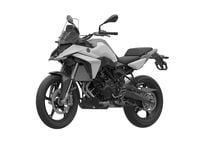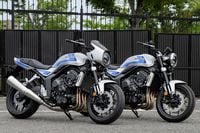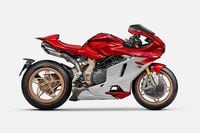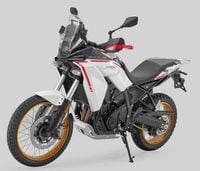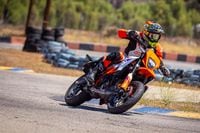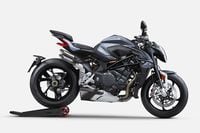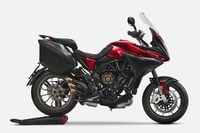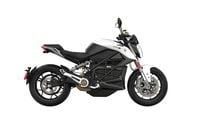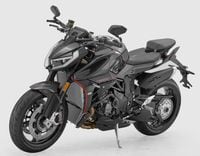Five minutes on board the Ducati Hypermotard and you instinctually want to do bad things. Suddenly riding on sidewalks feels normal and romping through parks seems appropriate. The Hyper, with its narrow seat, wide handlebars and supermoto-like feel just seems to bring out the adventurous little six-year-old within us all. Of course, performing any of these acts (or any other your inner child is dying to try) is surely to result in a less than pleasurable encounter with the Boys in Blue. You could say that this is the point though, as this is the machine that a few select Italian designers envisioned as their true play bike whenever they weren't conjuring up the latest and greatest racing machine.
First shown to the public at the 2005 EICMA show in Milan, the original Hypermotard wasn't originally planned for production-it was merely a design exercise to gauge public reaction. However, after the immensely positive responses it received, Ducati quickly reacted and put the bike into production in 2007. In its first year the bike was a smashing hit both in Europe and the U.S. Its 1100cc Desmodue dual-spark engine lifted straight from the Multistrada proved to be the perfect powerplant. In the years since, the Hyper has continued its success in Europe and is the second most popular Ducati behind the company's Superbikes. In Italy, there's even a spec class to race the Hypermotard called the Desmo Challenge. Here at home, sales have waned a little due to this country's love for the Monster line.
Still, three years is a long time for any performance-oriented machine to remain unchanged, especially when the rest of its siblings are all getting upgrades. Ducati engineers thought this too, and in between laying out the next Superbike they looked at the next version of the Hypermotard 1100. An evolution, if you will. The result is what you see on these pages-the Ducati Hypermotard 1100 Evo and Evo SP (Can you guess what the Evo stands for?) As with any evolution of a breed, the design focus here centered around two key points: more power and less weight. Yes those are popular catch phrases when it comes to new models, but considering the original Hypermotard was essentially a stripped down Multistrada, putting it on a diet and giving it some more grunt was hardly a tall order.
A Clean Sheet
When it came to cutting the pounds, the first spot Ducati engineers looked was at the frame. Upon further inspection it was found that the forged mounting points of the trellis frame could be removed and were instead precision machined. Focus then turned to the engine department where that team was given free reign to practically come up with an all-new engine, just as in the 796 version. And that they did. For starters, the engine is actually 1078cc (just like the previous model), though the crankcases on the new Desmodue Evoluzione engine receive the same vacuum die cast treatment as the company's Superbikes. This creates consistent wall thickness and increased strength. Combine this with a lighter flywheel based on the 848 and rare-earth magnets in the alternator and that's a weight savings of 11.5 pounds, or the weight of the human head! In a world where shaving grams is a success, riding headless (so to speak) is big. The new Hyper burns fuel entirely different than before due to a redesigned combustion chamber that sees a higher compression ratio thanks to new pistons. This is all burned via a single spark plug-the second biggest change from the previous dual-spark configuration-which necessitates the need for new camshafts. A switch to Siemens electronics (from Magnetti Marelli) is the biggest difference for the new models, due mainly to its faster microprocessor.
A new oil cooler with 85 percent more surface area keeps internal temps for the air-cooled engine under control, while the old unit finds its way down to the 796. From there changes to the bike are minor and include a different instrument cluster with new streamlined controls.
What The People Want
With the Hypermotard 796 in the lineup, Ducati now has an entry-level motard to satisfy those who are curious about the breed. That leaves the 1100 free to expand to more experienced riders. Confident that what they had created was truly an evolution of its predecessor we were invited to Scottsdale, Arizona to give the Evo and Evo SP a whirl. Ducati claims the new engine produces 95 horsepower (five more than before) with a broader torque curve as well. Starting with the standard Evo model, our seat-of-the-pants reaction tends to agree with that statement. There's plenty of torque available under 4000 rpm, but the difference now is the Evo will keep on pulling long after the original would have run out of steam.
For the casual street ride that awaited us, the Evo suited the conditions well. The softer 50mm Marzocchi fork paired with the Sachs shock was more compliant over road imperfections as well as highway bumps than the more racetrack-oriented Evo SP (more on that model later). Of course, suspenders on both ends are fully adjustable for preload, rebound and compression damping. Our ride was hampered by significant gravel lining the roads once we approached the twisty bits and it was here that we could fully appreciate the riding position and upright handlebar. Seeing as how motards love to be loose and sliding these roads proved to be perfect for the foot-out riding style. Standard Evo models come with Pirelli Diablo Rosso tires, which come to temperature quickly and provide remarkable levels of grip for a street-oriented tire.
With cast aluminum Marchesini wheels and the leverage that the handlebar gives, direction changes come rather quickly assuming you're the type of rider who likes to muscle a bike around. Bringing the action to a halt are two-piece four-pot Brembo calipers mated to 305mm discs in the front and a single 245mm disc in the rear partnered with a two-piston caliper. Despite the weak initial bite, clamping power is strong once engaged and the long lever travel makes for precise metering of the brakes-perfect for trailbraking to the apex while wagging the rear end.
Take It To Another Level
Remember earlier that bit about the Italian domestic racing series, the Desmo Challenge? Well those racers also had a say in what they wanted in the new Hypermotard, and basically they wanted a machine that was taller, lighter and more powerful. So instead of creating one bike to meet the demands of road riders and track junkies, Ducati did what they always do and released a higher-spec version of the Hypermotard 1100 Evo called the Evo SP. Engine internals are identical between the two bikes, but Desmo Challenge racers wanted something more track oriented. To do this, the 50mm Marzocchi fork in the SP has 30mm more suspension travel and consequently raises the ride height the same amount. Mated to the fork is an Öhlins shock, now commonplace on higher-spec Ducatis. Forged aluminum Marchesini wheels shed precious pounds compared to the standard cast pieces. Combine that with the 20mm handlebar risers and Pirelli Diablo Supercorsa SP tires and you have a machine that's born to live on the edge. You might think the higher ground clearance would negatively affect weight bias, but actually the racers requested this so they could have increased lean angle while sliding the bike into turns. Which is also why SP models come equipped with sliders under each peg.
Our SP test bikes were fitted with optional Termignoni exhausts that truly let the bike breathe. That difference is immediately noticeable the first time you twist the throttle as the front tire instantly paws at the sky. For the average rider who's under six feet tall the higher saddle will prop you on the tips of your toes, but it's not often that you should be at a stop on this bike anyway-this bike loves to move. Some of the journalists present complained about improper fueling causing the bike to act sluggish at low revs, but all we noticed was a lighter throttle return spring that rewarded us for being precise with our right hands. Changing direction with the SP was noticeably quicker compared to the standard Evo thanks to the lighter wheels, but the Supercorsa SP tires could never fully get up to temperature on this chilly day, dropping cornering confidence markedly. To make matters worse, the monobloc calipers taken directly from its Superbike cousins behaved completely unlike the Evo ridden before. Now initial bite was so strong it felt like the slightest tap of the lever would flip the bike on its head. Lever travel is consequently shortened dramatically making it difficult to precisely meter where one is on the brakes. Needless to say, riding adjustments had to be made quickly to avoid a catastrophe. We're sure a change of pads would cure this, but as it stood the brakes were just too good-which isn't something we normally complain about.
In its element-the racetrack-we can see where the SP would shine over the standard Evo model. Its superior components would make for a riot of a track toy (or racer if you live in Italy), but on this day and on these roads the standard Evo just proved that "lower spec" doesn't necessarily mean "less fun." No matter what you fancy, both the Evo and Evo SP truly are evolutions of the original that are sure to threaten driver's licenses everywhere.
Ducati Hypermotard 1100 EVO/EVO
MSRP: $11,995/$14,995
Engine
Type: Liquid-cooled, 90-deg., 4-stroke V-twin, SOHC, 2 valves/cyl.
Displacement: 1078cc
Bore x stroke: 98.0 x 71.5mm
Induction: Siemens EFI, single injector/cyl. 45mm throttle bodies
Chassis
Front tire: 120/70ZR-17 Pirelli Diablo
Rosso/Pirelli Diablo Supercorsa SP
Rear tire: 180/55ZR-17 Pirelli Diablo
Rosso/Pirelli Diablo Supercorsa SP
Rake/trail: 24.0 deg./3.9 in. (100mm)/24.0 deg./4.3 in. (108mm)
Wheelbase: 57.28 in. (1455mm)/57.68 in. (1465mm)
Claimed wet weight: 379 lb. (172 kg) Evo/ 377 lb. dry (171 kg) Evo SP
Seat height: 33.3 in./34.4 in.
Fuel capacity: 3.3 gal. (12.4 L)










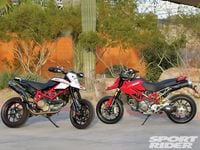
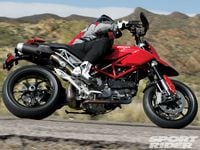
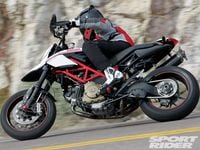
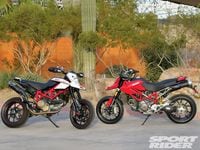
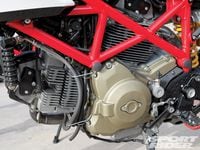
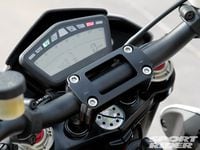
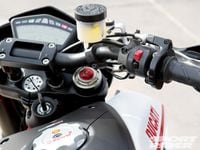
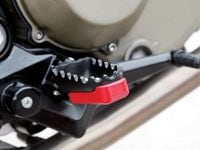
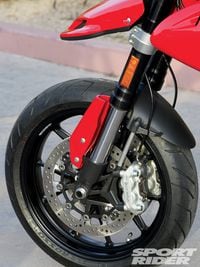
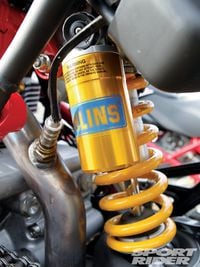
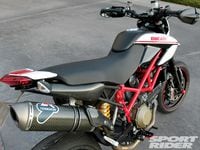
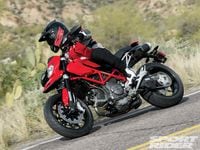
/cloudfront-us-east-1.images.arcpublishing.com/octane/6JPU4U2H7GOYZH2ZETYQBFLR2Q.jpg)
/cloudfront-us-east-1.images.arcpublishing.com/octane/CXNPUJDPPBCVHIRI5H7UOCX5HY.jpg)
/cloudfront-us-east-1.images.arcpublishing.com/octane/RZ5QNVGN4ZDRHJIKTPHGDX3HKA.jpg)
/cloudfront-us-east-1.images.arcpublishing.com/octane/ZGBASNGFXVBGXAQGDM6EWLNFXA.jpg)
/cloudfront-us-east-1.images.arcpublishing.com/octane/54BEFUE3XBDCTCAYUYQNZGAJV4.jpg)
/cloudfront-us-east-1.images.arcpublishing.com/octane/5XF2ZKSOR5G7TO23KSYT4JADTU.jpg)
/cloudfront-us-east-1.images.arcpublishing.com/octane/VHUK3FH6WFHLTHN7CKCATU36LM.jpg)
/cloudfront-us-east-1.images.arcpublishing.com/octane/HC4P3CYOXFF3NGXCQTGORFRYNY.jpg)
/cloudfront-us-east-1.images.arcpublishing.com/octane/ZNANUJGGKVBIFH3VRZ32BYC454.jpg)
/cloudfront-us-east-1.images.arcpublishing.com/octane/JACAJ4MPKJBTDBOZRTHXZAKLTA.jpg)
/cloudfront-us-east-1.images.arcpublishing.com/octane/7L3YWQXRBRECXMWQ6NBVAHU2EY.jpg)
/cloudfront-us-east-1.images.arcpublishing.com/octane/BPD5CKH5IFGDLG67Y24UMOXXGA.jpg)
/cloudfront-us-east-1.images.arcpublishing.com/octane/CHQ32B6TVBEPVFNPERY3AB2H3M.jpg)
